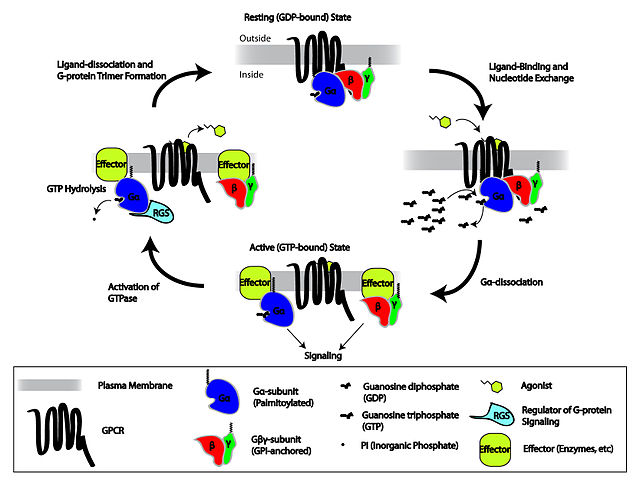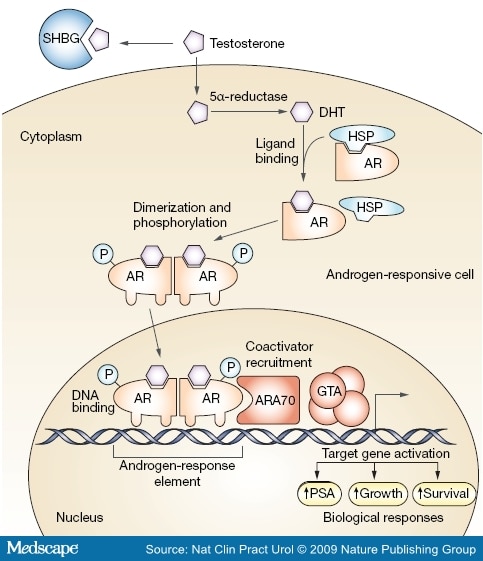Daily Newsletter
October 15, 2013 - Direct vs. Indirect Signals
Signal transduction involves a signal contacting an appropriate receptor which ellicits a cellular effect. The transduction is thus the changing of signal into an effect. Transduction can be either direct or indirect.
A direct transduction event implies that the receptor ellicits an immediate effect on the cell. A good example of this is the Androgen (Testosterone) Receptor. The image below is a good image of the basic signal transduction pathway. Testosterone is lipid soluble, so can easily move through the membrane. Once inside of the cell, it is changed to dihydroxytestosterone (DHT). This binds to the receptor, and then the receptor-ligand complex is moved into the nucleus. Inside of the nucleus it directly affects the transcription of genes. In this case, the receptor-ligand complex has a direct effect on the cell.
Indirect signal transduction will involve the creation of a secondary messanger. The receptor-ligand complex will create a condition where an intracellular chemical signal is created. One primary signal binding to the receptor can then be amplified within the cell by creating this secondary messanger. Below is a general diagram showing the use of a G-Protein interface. The Ligand-Receptor complex directly activates the G-Protein. The activated complex then activates a specific effector in the cell membrane.

In the above image, there are four views of the Receptor-G-Protein complex. In the top image of the cycle, the Resting State, there is no ligand bound to the receptor. When the ligand binds (the next image in the cycle), GTP binds to the Gα subunit. This causes the Gα subunit to detach from the rest of the G-protein (Gβγ Subunit). The subunits then bind to Effectors.
A very prevelant effector enzyme is Adenylat
 e Cyclase. This enzyme takes ATP (Adenosine Triphosphate) and removes two phosphates. The remaining phosphate binds back to the ribose sugar at the 3' carbon, creating a ring structure (cycle) between carbon 5' and 3'. This is known as cyclic AMP (cAMP). cAMP is a very common secondary messanger. It can be produced in bulk and can bind to a variety of enzymes.
e Cyclase. This enzyme takes ATP (Adenosine Triphosphate) and removes two phosphates. The remaining phosphate binds back to the ribose sugar at the 3' carbon, creating a ring structure (cycle) between carbon 5' and 3'. This is known as cyclic AMP (cAMP). cAMP is a very common secondary messanger. It can be produced in bulk and can bind to a variety of enzymes.A good example of a cAMP regulated protein is Protein Kinase A (PKA). This is a cAMP Dependent Protein Kinase. The function of this family of proteins varies depending upon the cell (i.e., the current proteome of the cell). For example, in adipose tissues, PKA activates pathways for lipolysis (breakdown of triglycerides), while in skeletal myofibers (myocyte or muscle cell) you see activation of glycogenolysis (breakdown of glycogen), inhibition of glycogenosis (making of glycogen), and increased rates of glycolysis.
Why would phosphorylation affect protein activiation? Phosphates are large with a -2 charge. Binding a phosphate to a protein will force the protein to change shape (configurational change).
Below is an example of indirect signal transduction via a G-protein:

Here is another picture of the G-protein to help you visualize the process.



No comments:
Post a Comment